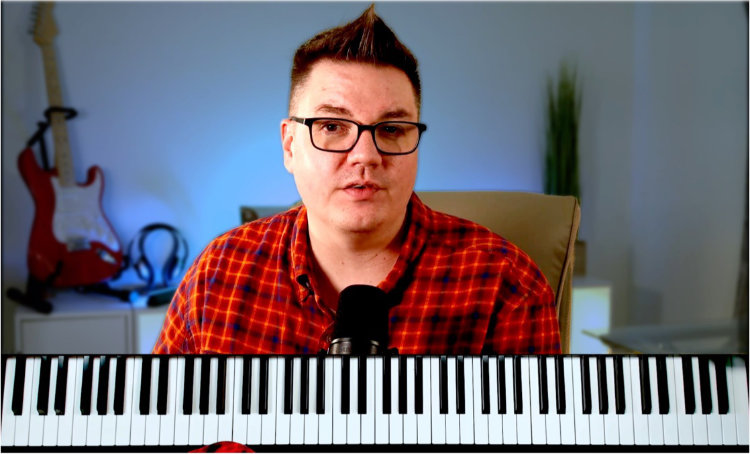Major chords are one of the first things we learn about when playing the piano. But, it's critical that we know how to put those chords into practice in our hands through practical chord voicing.
How do I voice a major 7th chord? A major 7th voicing needs to include its most important 3 notes, including the root, 3rd and 7th. The root is played in the left hand, with the 3rd and 7th in the right hand.
This article is part of my series on Foundational Chord Voicings. Make sure to check out the other relevant parts of this series on minor chord voicings, and dominant chord voicings.
The Notes of the Major 7th chord #
What is a major 7th chord? A Major 7th chord is a 4-note chord consisting of the root, 3rd, fifth and major-7th. You can build the chord upwards from its root by stacking major-3rd, minor-3rd and major-3rd intervals.
The major-7th chord is built using the 1, 3, 5 and 7 from the major scale.
Here's a Cmaj7 chord:
Root Position Voicing #
The chord shown above is a root position voicing. If you learned about major chords from a classical piano teacher, this is just a grown up, jazzier, version of that same chord. As we look to explore a variety of different ways to voice this chord, it's important first that we know the notes for these chords in all twelve keys.
Major 7th Chords in Root position: #


Step-by-Step Video Training
As a premium member of Jazz-Library you will have access to our Jazz Fundamentals video course which has 70+ video lessons teaching you these chords, chord voicings, comping rhythms and more.
Major 7th Chord Inversions #
These root position chords can also be inverted, to reorder their notes. This is useful to create smooth voice-leading between it and other chords. To invert the chords, we take some of the notes off the bottom of the voicing and move them to the top.
Major 7th Chords in 1st Inversion: #
1st Inversion chords are built by taking 1 note off the bottom of the root positioned voicing, and moving it up an octave to the top of the voicing.

To make them easier to read, I've dropped some of these chords by an octave.
Major 7th Chords in 2nd Inversion: #
2nd Inversion chords are built by moving 2 notes from the bottom of the root positioned voicing, and playing them on top of the voicing instead.

Major 7th Chords in 3rd Inversion: #
Following the same process, we can create 3rd inversion major-7th chord voicings:

3-Note Voicings #
3-note voicings are the cornerstone of all jazz voicings. As the name suggests, 3 note voicings have 3 notes instead of 4: the root, the 3rd and the 7th. The fifth is removed.
These voicings can be played in either hand, or across both hands. I suggest practicing them by playing them with both hands, the root in your left, and the 3rd and 7th in your right.
A-Voicings #
There are two inversions of 3-note voicings that we call A and B voicings. In this A voicing, the 3rd is on the bottom of your right hand, and the 7th on top:
Here's a Cmaj7 chord as an example:
B-Voicings #
To play the B voicing keep the root in your left hand, but switch the notes in the right hand to put the 7th on the bottom.
Here's the same Cmaj7 chord in B voicing:
Rootless Voicings #
Once you've mastered your 3-note voicings, we can upgrade to rootless voicings. Rootless voicings make your major-7th chords sound rich and full.
As you can tell from the name, rootless voicings remove the root from the chord. On top of that, we add the 5th back to the chord and the 9th as well.
Rootless voicings are useful to fill out chords in your right hand, while you left plays a bass line. But just as important, playing these in your left hand will give you freedom to improvise with your right. So, take time to learn these in both hands.
Substitute the 6 for the 7 #
It might sound odd to have a 7th chord without the 7th in it. Some of my literalist friends freak out about it, but its actually quite common. Any time you see a major-7th chord in a tune, you should consider whether to play the 7 or the 6 in the voicing.
Most importantly, when the melody note is the root of the chord, you'll almost always want to play the 6 instead of the 7. The minor-2nd interval created between the 7th and the root is highly dissonant, where the 6th is much more consonant.
Beyond melodic considerations, the two chords have similar but unique sound qualities. Feel free to pick either version, depending on how you are feeling in the moment.
In the diagrams below I've notated them using the 7th, but practice swapping the 7 for the 6 as well.
A-Voicings #
Our rootless voicings have A and B variations, just like our 3-note voicings. The A voicings start with the 3rd on the bottom:
The A-voicing is structured as 3-5-7-9.
B-Voicings #
THe B-voicings contain the same notes, but rearranged to have 7th on the bottom.
The B-voicing is structured as 7-9-3-5.
Adding Color with the Sharp-11 #
To add even more color to your major-7th voicings, you can experiment with adding the sharp-11. It adds a Lydian flavor to your voicing, and for that reason, it works particularly well on the iv chord in a major key.
Pro tip: The addition of the sharp 11 can sound dissonant. The 3rd and sharp 11 can clash, so you may consider removing the 3rd to clean it up. That said, sometimes that dissonance just sounds too good to remove.
Fourth Voicings #
Everything we've shared so far has involved building chords in 3rds: (1,3,5,7,9,11), and creating inversions of the resulting chords. For a wider, hipper sound, we can build voicings on top of 4ths as well.
My examples below use the following sequence of notes in 4th intervals to build voicings: 3-6-9-5-1, as one example. It can feel a little strage building chords in 4ths, especially if you've trained on classical theory. Stick with it, these voicings add a lot of new tools in your toolbox.
Pro tip: It can be easier to think about 4th voicings from the top down, rather than the bottom up. That's because the primary chord tones generally are at the top of these voicings.
Inversion with Root on Top #
From the top down: 1-5-9-6-3
Inversion with 5th on Top #
Also, from the top down: 5-9-6-3-7
Practice Tips #
In order to use these voicings in songs and improvisation, you'll have to internalize them. Here are some exercises I use to get comfortable:
- Play them through the circle of 5ths, counter-clockwise and clockwise.
- Play them chromatically
- Play them in diatonic scales
- Use flash cards to drill them randomly.
Play all four of those techniques with the chords in your right hand, then in your left, and then both hands together.
